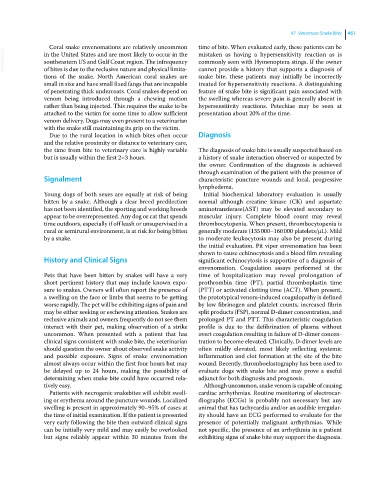Page 493 - Clinical Small Animal Internal Medicine
P. 493
47 Venomous Snake Bites 461
Coral snake envenomations are relatively uncommon time of bite. When evaluated early, these patients can be
VetBooks.ir in the United States and are most likely to occur in the mistaken as having a hypersensitivity reaction as is
southeastern US and Gulf Coast region. The infrequency
commonly seen with Hymenoptera stings. If the owner
of bites is due to the reclusive nature and physical limita-
snake bite, these patients may initially be incorrectly
tions of the snake. North American coral snakes are cannot provide a history that supports a diagnosis of
small in size and have small fixed fangs that are incapable treated for hypersensitivity reactions. A distinguishing
of penetrating thick undercoats. Coral snakes depend on feature of snake bite is significant pain associated with
venom being introduced through a chewing motion the swelling whereas severe pain is generally absent in
rather than being injected. This requires the snake to be hypersensitivity reactions. Petechiae may be seen at
attached to the victim for some time to allow sufficient presentation about 20% of the time.
venom delivery. Dogs may even present to a veterinarian
with the snake still maintaining its grip on the victim.
Due to the rural location in which bites often occur Diagnosis
and the relative proximity or distance to veterinary care,
the time from bite to veterinary care is highly variable The diagnosis of snake bite is usually suspected based on
but is usually within the first 2–3 hours. a history of snake interaction observed or suspected by
the owner. Confirmation of the diagnosis is achieved
through examination of the patient with the presence of
Signalment characteristic puncture wounds and local, progressive
lymphedema.
Young dogs of both sexes are equally at risk of being Initial biochemical laboratory evaluation is usually
bitten by a snake. Although a clear breed predilection normal although creatine kinase (CK) and aspartate
has not been identified, the sporting and working breeds aminotransferase(AST) may be elevated secondary to
appear to be overrepresented. Any dog or cat that spends muscular injury. Complete blood count may reveal
time outdoors, especially if off leash or unsupervised in a thrombocytopenia. When present, thrombocytopenia is
rural or semirural environment, is at risk for being bitten generally moderate (135 000–160 000 platelets/μL). Mild
by a snake. to moderate leukocytosis may also be present during
the initial evaluation. Pit viper envenomation has been
shown to cause echinocytosis and a blood film revealing
History and Clinical Signs significant echinocytosis is supportive of a diagnosis of
envenomation. Coagulation assays performed at the
Pets that have been bitten by snakes will have a very time of hospitalization may reveal prolongation of
short pertinent history that may include known expo- prothrombin time (PT), partial thromboplastin time
sure to snakes. Owners will often report the presence of (PTT) or activated clotting time (ACT). When present,
a swelling on the face or limbs that seems to be getting the prototypical venom‐induced coagulopathy is defined
worse rapidly. The pet will be exhibiting signs of pain and by low fibrinogen and platelet counts, increased fibrin
may be either seeking or eschewing attention. Snakes are split products (FSP), normal D‐dimer concentration, and
reclusive animals and owners frequently do not see them prolonged PT and PTT. This characteristic coagulation
interact with their pet, making observation of a strike profile is due to the defibrination of plasma without
uncommon. When presented with a patient that has overt coagulation resulting in failure of D‐dimer concen-
clinical signs consistent with snake bite, the veterinarian tration to become elevated. Clinically, D‐dimer levels are
should question the owner about observed snake activity often mildly elevated, most likely reflecting systemic
and possible exposure. Signs of snake envenomation inflammation and clot formation at the site of the bite
almost always occur within the first four hours but may wound. Recently, thromboelastography has been used to
be delayed up to 24 hours, making the possibility of evaluate dogs with snake bite and may prove a useful
determining when snake bite could have occurred rela- adjunct for both diagnosis and prognosis.
tively easy. Although uncommon, snake venom is capable of causing
Patients with necrogenic snakebites will exhibit swell- cardiac arrhythmias. Routine monitoring of electrocar-
ing or erythema around the puncture wounds. Localized diographs (ECGs) is probably not necessary but any
swelling is present in approximately 90–95% of cases at animal that has tachycardia and/or an audible irregular-
the time of initial examination. If the patient is presented ity should have an ECG performed to evaluate for the
very early following the bite then outward clinical signs presence of potentially malignant arrhythmias. While
can be initially very mild and may easily be overlooked not specific, the presence of an arrhythmia in a patient
but signs reliably appear within 30 minutes from the exhibiting signs of snake bite may support the diagnosis.

